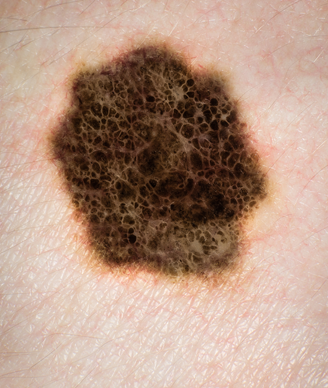Later-Line PD-1 Inhibitor Improves Melanoma Outcomes
Advanced melanoma patients who progressed on ipilimumab were more likely to achieve an objective response when treated with nivolumab than with chemotherapy.
Image © Australis Photography / Shutterstock.com

More patients with advanced melanoma who had progressed on ipilimumab with or without a BRAF inhibitor were able to achieve an objective response when treated with the PD-1 immune checkpoint inhibitor nivolumab than with alternative chemotherapy options, according to the interim analysis results of the CheckMate 037 trial published recently in Lancet Oncology.
In fact, the rate of objective response was about threefold greater with nivolumab compared with investigator’s choice of chemotherapy; however, no difference in progression-free survival in the intention-to-treat population was noted.
These results were the basis of the December 2014 US Food and Drug Administration accelerated approval of nivolumab for this patient population.
“Findings from our study show that nivolumab leads to clinically meaningful improvements in the proportion of patients achieving an objective response and provide a manageable safety profile when compared with chemotherapy,” wrote Jeffrey S. Weber, MD, of Moffitt Cancer Center, Tampa, Florida, and colleagues. “Nivolumab can now be considered as a new treatment option for patients that have progressed after ipilimumab, or a BRAF inhibitor and ipilimumab if their melanoma is BRAF V600–mutated.”
CheckMate 037 was a phase III, open-label, double-blind study where patients with advanced melanoma that had progressed on ipilimumab or ipilimumab plus a BRAF inhibitor were randomly assigned 2:1 to nivolumab (n = 272) or investigator’s choice of chemotherapy (n = 133).
With a median follow-up of 8.4 months, researchers confirmed objective responses in 31.7% of patients assigned nivolumab (95% CI, 23.5–40.8) compared with 10.6% of patients assigned chemotherapy (95% CI, 3.5–23.1). Within the intention-to-treat population, the confirmed objective response rate was 31.1% for nivolumab compared with 8.3% for chemotherapy.
At this interim analysis, the median duration of response for patients assigned nivolumab had not yet been reached and was 3.5 months for patients assigned chemotherapy. In the intention-to-treat population, median progression-free survival was 4.7 months for nivolumab compared with 4.2 months for chemotherapy.
“The absence of significant difference in progression-free survival could be attributed in part to the imbalance in distribution of adverse prognostic factors in favor of the [chemotherapy] group, immaturity of the data, and the false-positive disease progression in the nivolumab group due to the use of RECIST version 1.1 as opposed to immune-related response criteria for tumor assessment,” the researchers wrote.
The researchers also found that objective responses occurred among 44% of patients with PD-L1 overexpression assigned nivolumab compared with 9% assigned chemotherapy. Complete or partial responses occurred more frequently among patients assigned nivolumab than chemotherapy, regardless of the patient’s BRAF status or previous anti-CTLA-4 benefit.
Grade 3/4 serious adverse events occurred in 5% of patients assigned nivolumab and 9% of patients assigned chemotherapy. Other grade 3/4 adverse events of nivolumab included lipase (1%), increased alanine aminotransferase (1%), anemia (1%), and fatigue (1%). Patients assigned chemotherapy had grade 3/4 neutropenia (14%), thrombocytopenia (6%), and anemia (1%).
In an editorial that accompanied the results, Gerald Falchook, MD, of the Sarah Cannon Research Institute at HealthONE, Denver, Colorado, wrote: “Similar to other targeted treatments, investigators are searching for predictive biomarkers of efficacy for immunotherapy drugs. Across different tumor types, responses to anti-PD-1 or anti-PD-L1 treatment have been associated with PD-L1 tumor expression, T helper type 1 gene expression, CTLA-4 expression, and the absence of fractalkine expression (CX3CL1) in baseline tumor specimens. Future studies could further refine such findings and prospectively establish which patients are unlikely to benefit from immunotherapy.”
Newsletter
Stay up to date on recent advances in the multidisciplinary approach to cancer.